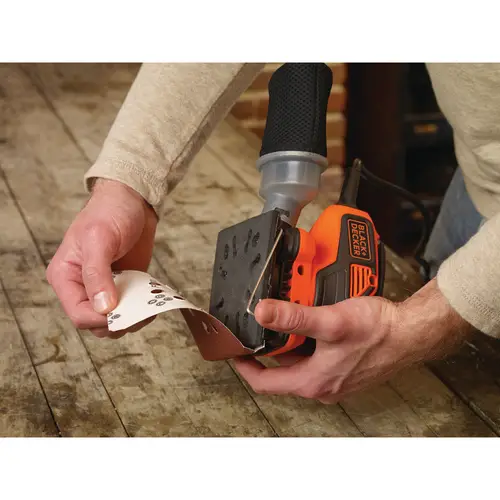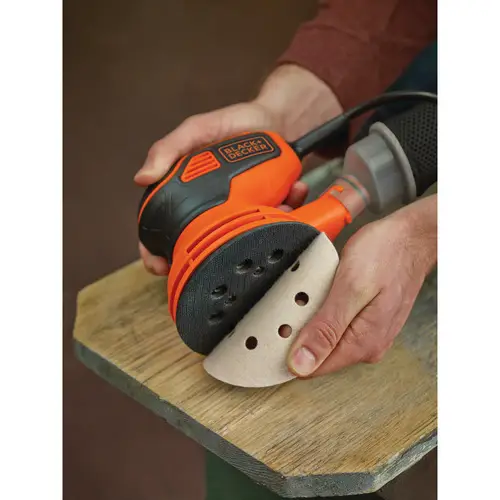What is a Random Orbit Sander?
A Random Orbit Sander is a woodworking power tool featuring a circular piece of heavy-duty sandpaper mounted on a round metallic pad connected to a high-torque AC motor. This handy woodworking tool, also known as a Rotary Sander, significantly reduces the time and effort you would spend carrying out manual wood sanding on wooden surfaces. You can use a random orbit sander to efficiently perform a wide array of sanding tasks, including:
- Stripping layers of old paint from wooden surfaces when intending to apply a fresh coat of the same or different colored paint
- Removing varnish from furniture surfaces to allow proper application of a new wood finish
- Smoothing down wooden surfaces before applying a coating of wood varnish or paint
- Tackling large-scale sanding tasks on wooden building projects such as wooden floors, staircases, decks, patios, railing, and so forth.
Random Orbit Sander versus Orbital Sander
Another electric sanding tool that is remarkably easy to confuse with the random orbit sander is the Orbital Sander. You can use an orbital sander to carry out similar sanding tasks as those performed using a random orbital sander. However, differences in the mode of operation of these two power sanders make each electric sander more suited to specific sanding tasks.
Therefore, you need to learn the unique differences between random orbit and orbital sanders if you want to optimize your sanding tasks. Luckily, the woodworking knowledge presented in the next section of this article ensures you always choose the right electric sander for the right job.
Visual Differences Between Random Orbit and Orbital Sanders
Distinguishing between a random orbit sander and an orbital one is the first thing you need to know before you can adequately utilize these powered sanding tools. This feat involves looking for distinct external features that characterize these two electric sanding tools. Visible traits you can use to identify either type of sander correctly include: –
-
The shape of the Mounting/Backing Pad
Both sanders require you to attach a piece of sandpaper to the mounting pad before you can embark on a sanding operation. The mounting pad of a random orbit sander is circular, while an orbital sander is square or rectangular.
-
The shape of the Sandpaper
The shape of the sandpaper you use with either electric sander depends on the mounting pad’s shape. Consequently, the mounting pad on an orbital sander requires that you attach a rectangular 9inch by 11inch sandpaper. On the other hand, you can only mount disc-shaped sandpaper when using a random orbit sander for powered sanding tasks.
-
Sandpaper Fastening Mechanism
Loading a piece of sandpaper to a random orbit sander involves aligning perforations on sanding discs to tiny hooks on the underside of the mounting or backing pad. The recessed hooks on a random orbit sander ensure the circular sandpaper stays in place as you meticulously sand a wooden surface.
In comparison, the fastening mechanism on an orbital sander consists of two wire clips located on top of the backing pad. These stainless steel clips firmly hold the two ends of rectangular or square sandpaper to the pad as you perform a sanding operation.
Sanding Capabilities of a Random Orbit versus an Orbital Sander
In addition to differences in exterior appearance, a random orbit sander’s sanding abilities differ markedly from that of an orbital sander. This performance difference arises from how each power sander operates, as outlined below.
Using a Random Orbit Sander
After you attach a sanding disc to a random orbit sander, you power up the tool and press the tool’s sanding end onto the target wood. The sanding’s high-torque AC motor causes the rotation of the sanding disc over a target area equivalent to the diameter of the disc. Proper sanding using a random orbit sander involves moving the rotating sanding pad of this electric sander systemically over a wooden surface.
During a sanding operation using a random orbit sander, a mechanism below the AC motor ensures that the sanding pad moves in random concentric orbits over the wooden surface. This precise but random rotational motion ensures that this electric sander avoids creating distinct sanding patterns on the surface that you are sanding.
As a result, using a random orbit sander allows you to realize an impeccably smooth surface with minimal cross-grain scratching. Furthermore, this electric sander’s random circular motion allows you a high material removal rate from a wooden surface.
Using an Orbital Sander
As with a random orbit sander, you begin your sanding task with an orbital sander by first attaching rectangular or square sandpaper to the backing pad. You then power up this electric sander and press it firmly against the target wooden surface. However, unlike a random orbit sander whose AC motor generates a circular sanding motion, the motor of an orbital sander causes the mounting/backing pad’s to-and-fro movement.
As a result, you achieve a sanded surface bearing distinct sanding patterns with clearly visible cross-grain scratching when you use this electric sander. Furthermore, the sanding end of this woodworking power tool’s basic to-and-from movement translates to a low material-removal rate when you are using an orbit sander.
What is a Random Orbit Sander and Why use One Over an Orbital Sander?
Using a random orbit sander for your sanding tasks provides you with notable advantages over using an orbital sander. First and foremost, you attain a significantly higher rate of material removal from wooden surfaces when using a random orbit sander than possible with an orbital electric sander. Second, choosing a random orbit sander for your sanding tasks allows you to realize a smoother wood sanding finish than with an orbital sander. The outcome is that a random orbit sander allows you to use far less time and effort to perform similar sanding tasks than would be necessary with an orbital sander.
Consequently, a random orbit sander’s faster and smoother sanding performance makes this electric sanding tool a better fit for powered sanding tasks than an orbital sander. However, a random orbit sander’s circular pad is why this electric sanding tool falls short when intending to smooth out corners and angled surfaces.
Here are 2 budget options for sanders depending on your needs. Both are the top of the class on Amazon and very reasonably priced.
- Random orbital action for high removal rate and a high quality finish
- Hook and loop system for fast and easy paper changes
- Dust sealed switch to keep all dust and debris out
- Included Components: (1) Sander, (1) Sanding Sheet, (1) Dust Bag
Prices pulled from the Amazon Product Advertising API on:
Product prices and availability are accurate as of the date/time indicated and are subject to change. Any price and availability information displayed on [relevant Amazon Site(s), as applicable] at the time of purchase will apply to the purchase of this product.
- Provides 270 degree flush sanding clearance
- Tri-layer filtration
- Soft grip paddle switch
- Paddle switch activation for easy on/off during application
- Included Components: (1) Sander, (1) Sheet Sandpaper, (1) Paper Punch, (1) Dust Bag
- Paddle switch activation for easy on/off during application
- 2.0 amp motor for material removal with 1,600 orbits per minute
- High-performance dust collection to provide a clean work surface
- Ideal for finish sanding and detail work
Prices pulled from the Amazon Product Advertising API on:
Product prices and availability are accurate as of the date/time indicated and are subject to change. Any price and availability information displayed on [relevant Amazon Site(s), as applicable] at the time of purchase will apply to the purchase of this product.

